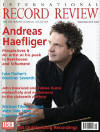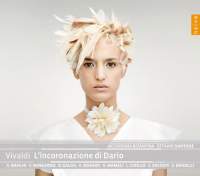Texte paru dans: / Appeared in: |
|
|
Reviewer: Nicholas
Anderson Vivaldi's years as an opera composer embrace a period between 1713 and 1739. Contemporary reports of performances are seldom as plentiful as we should like but among those which have survived is one which records that in January 1717 ‘the magnificent "Incoronazione di Dario" opened with great applause'. The work was premiered at the Venice theatre of Sant' Angelo as part of the 1717 winter carnival season. Adriano Morselli's libretto had been written over 30 years earlier for an opera by another Venetian composer, but a revised version, perhaps by Domenico Lalli, whom Vivaldi set on at least a handful of occasions, proves effective. The historically based plot is set in the fifth centurv BC at the Persian court. It provides an opportunity for a three‑cornered fight for the crown, following the death of King Cyrus. Dario enjoys the support of senior governors and politicians while young nobleman Oronte is the people's choice. Arpago, an army captain, is backed by the militia. The victor is promised Cyrus's beautiful but dim‑witted daughter, Statira, in marriage but obstacles lie in the persons of Statira's scheming younger sister Argene and the philosopher Niceno, who is their guardian but who entertains lustful intentions towards Statira. All ends happily but not before ruthless Argene has almost achieved her ambition. She alone remains unforgiven for her deceit and is condemned by Dario to lifelong imprisonment. Statira and Argene are both alto roles but their music, reflecting their vastly different characters, is clearly differentiated. Untypically, Vivaldi allotted the 'primo uomo' role of Dario to a tenor as opposed to the more frequently encountered castrato. Oronte and Arpago are soprano roles as is that of princess Alinda. She loves Oronte. The bass role of Nicenco, contains an unusual feature in its inclusion (Act 1) of a little 'cantata in scena' which he has written for Statira to sing while he accompanies her on a viola all'inglese (viola da gamba). Angelo Zannoni, who sang the role of Niceno in 1717, was apparently a virtuoso of the instrument. The varied character, colour and structure of the arias tap into a particularly rich vein of Vivaldi's dramatic creativity. While some are simply accompanied by basso continuo, others contain a wonderful range of instrumental obbligatos. Nicene's 'Non lusinghi il core amante' (Act 2) is striking for its florid bassoon accompaniment while 'Lo spietato e crudo amore' (Act 2), in which Argene's confidante Flora reflects on love's cruelty, is coloured by two hunting horns. Arpago's 'Cinto il crin' (Act 1) has some characteristically Vivaldian violin writing, while Niceno's lively 'Quale all'onte' at the end of Act 2 features two oboes. Vivaldi's most virtuosic vocal writing belongs to the role of Argene, as we can marvel at in arias like 'Ferri, ceppi' (Act 3). In this simile aria and plentifully elsewhere, too, Vivaldi's skill in vivid depiction is rewarding. Statira's 'Se palpitarti in sen' (Act 2) and her beguiling 'Sentirò fra ramo e ramo' (Act 3) are but two such instances.
The plot unfolds swiftly under
Ottavio Dantone's experienced direction and the cast of vocalists, led by
Anders Dahlin and Sara Mingardo, is uniformly strong. The instrumentalists
of Accademia Bizantina are on splendid form and the introductory
threemovement Sinfonia in C major is dispatched with aplomb. Recorded sound
is effectively spacious in this studio production and the booklet contains
the full Italian libretto with parallel English and French translations.
Accompanying essays are provided by the seemingly indefatigable Frédéric
Delaméa. |
|
|
|
|
|
Cliquez l'un ou l'autre
bouton pour découvrir bien d'autres critiques de CD |
|




